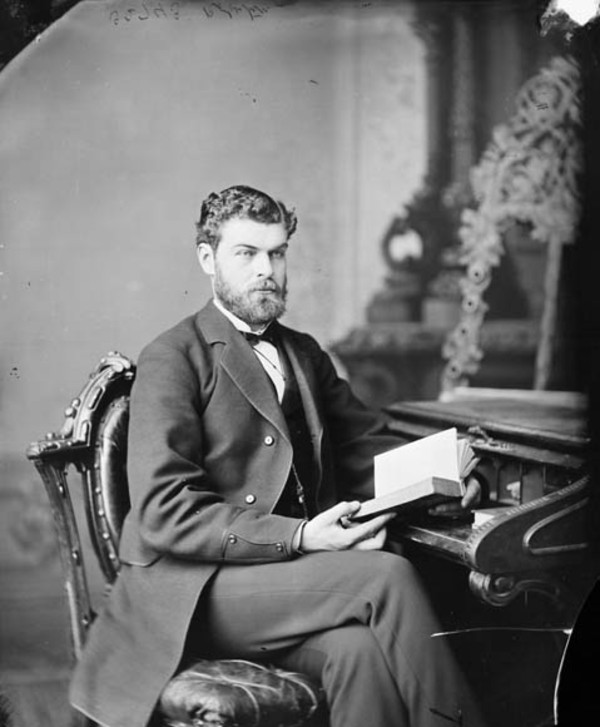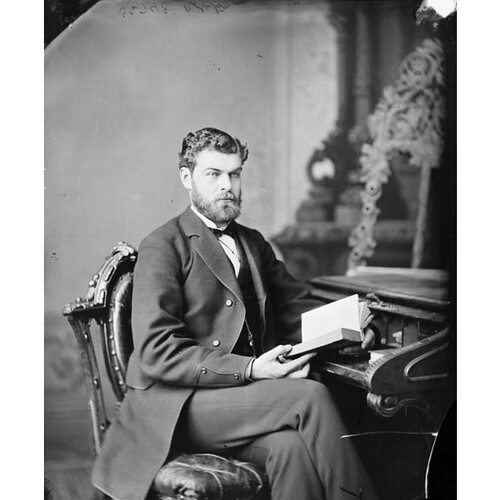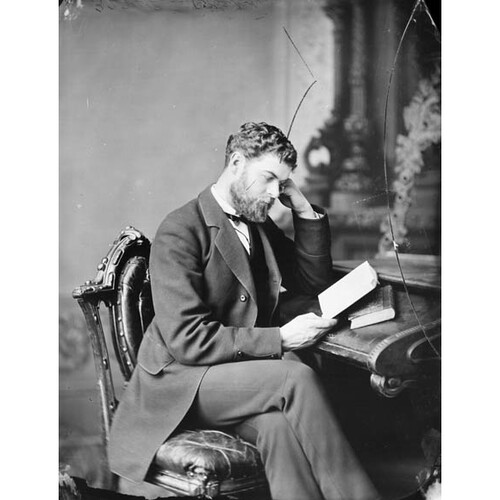ROBERTSON, THOMAS, civil servant, author, entrepreneur, and politician; b. 13 Sept. 1852 in Barrington Passage, N.S., eldest son of Robert Robertson and Sarah Richan; m. 10 Jan. 1884 Josephine Hume Allan of Lockeport, N.S., and they had four sons, one of whom, Wishart McLea Robertson, became speaker of the Senate and a delegate to the United Nations; d. 19 April 1902 in Dell Rapids, S.Dak.
Thomas Robertson was educated in Barrington Passage, and between 1868 and 1877 he was a provincial civil servant in the Department of Public Works and Mines and the office of the provincial secretary. He also apparently worked in the immigration branch of the federal Department of Agriculture. In 1871 his essay on Shelburne County came second in the contest for the Akins Historical Prize [see Thomas Beamish Akins*], and two years later he won with a history of Digby County.
As an entrepreneur, Robertson supported ventures dedicated to the improvement of his region. In 1883 he became president of the Barrington and Cape Island Steam Ferry Company, formed to provide safe transportation over the mile of turbulent water between Barrington Passage and North East Point on Cape Sable Island. Three years later in Barrington Passage he established the Cape Sable Advertiser, with Moses Hardy Nickerson as editor. The newspaper, which survived until 1890, supported the Liberal party and promoted interest in the Maritime fisheries. In 1898 Robertson was elected an officer of the Canadian Atlantic Canning Company of Lockeport, which was to can fish employing a method developed by a member of the company.
Robertson’s greatest contribution to the area came with his promotion of a local railway line. The Coast Railway Company, which was incorporated in 1893 with Robertson as president, was to construct a narrow-gauge line between Yarmouth and Lockeport. There was strong opposition from the backers of a standard-gauge railway from Halifax to Yarmouth, who had incorporated the South Shore Railway in the same year. Undaunted, Robertson began work on the Coast Railway with hand labour and wheelbarrows, the Conservatives dubbing the line “Tom Robertson’s Wheelbarrow Railroad.” The South Shore Railway went into liquidation in 1895, and by 1899 the Coast Railway had been completed between Yarmouth and Barrington Passage, but there was growing pressure for a standard-gauge railway which would connect with other lines in the province. Robertson therefore obtained for the Coast Railway a new provincial charter for a standard-gauge railway from Yarmouth to Halifax, to be called the Halifax and Yarmouth Railway. In the reorganization that followed Robertson was replaced as president, and in 1901 he began to negotiate with an American company to take over the existing line. That year, however, William Mackenzie* and Donald Mann* of the Canadian Northern Railway obtained a charter from the provincial and federal governments to build a line from Halifax to Yarmouth, the Halifax and South Western Railway, and they gradually took over companies in western Nova Scotia. The Halifax and Yarmouth Railway was acquired three years after Robertson’s death, and the Halifax and South Western was completed in 1906.
Robertson had begun his political career in 1878 when he ran in a provincial by-election for Shelburne, previously represented by his father. Although he failed to take the seat, later the same year he was elected to the House of Commons as a Liberal for Shelburne. Successful again in 1882 and 1887, he was defeated in a by-election held in 1888 after the 1887 contest had been voided because of bribery by his agents. The by-election was also declared null, but Robertson did not run again. In 1894 he was elected to the provincial legislature for Shelburne in the Liberal victory. Chosen speaker in February 1902, he left after the closing of the session to visit his brother Henry McNeil in South Dakota, hoping a change of climate would benefit his health. There he died on 19 April 1902. His body was brought home for burial in the family plot. Hundreds of mourners from Yarmouth and along the shores came to the funeral on a special train which passed over the rails he had worked to have laid.
Rural Municipality of Barrington, N.S., “Inventory of heritage buildings,” T. D. Atkinson, coordinator. H. R. Banks, “The Barrington Robertsons,” N.S. Hist. Rev., 3 (1983), no.1: 94–111; “Cape Sable Island ferries,” N.S. Hist. Quarterly, 5 (1975): 265–76; and “The Coast Railway: ‘Tom Robertson’s Wheelbarrow Railroad,’” NS. Hist. Rev., 6 (1986), no.2: 11–16. Canadian directory of parl. (Johnson). Edwin Crowell, A history of Barrington Township and vicinity . . . 1604–1870 (Yarmouth, N.S., [1923]; repr. Belleville, Ont., 1973). M. E. Messenger, Moses H. Nickerson ([Centreville, N.S.], 1981). The Nova Scotia law index, embracing all the private and local legislation of the province of Nova Scotia, down to and including the year 1900, comp. H. H. Bligh (Halifax, 1901). Ragged Islands “flashback” (Lockeport, N.S., n.d.).
Cite This Article
Marion Robertson, “ROBERTSON, THOMAS,” in Dictionary of Canadian Biography, vol. 13, University of Toronto/Université Laval, 2003–, accessed December 20, 2025, https://www.biographi.ca/en/bio/robertson_thomas_13E.html.
The citation above shows the format for footnotes and endnotes according to the Chicago manual of style (16th edition). Information to be used in other citation formats:
| Permalink: | https://www.biographi.ca/en/bio/robertson_thomas_13E.html |
| Author of Article: | Marion Robertson |
| Title of Article: | ROBERTSON, THOMAS |
| Publication Name: | Dictionary of Canadian Biography, vol. 13 |
| Publisher: | University of Toronto/Université Laval |
| Year of publication: | 1994 |
| Year of revision: | 1994 |
| Access Date: | December 20, 2025 |





